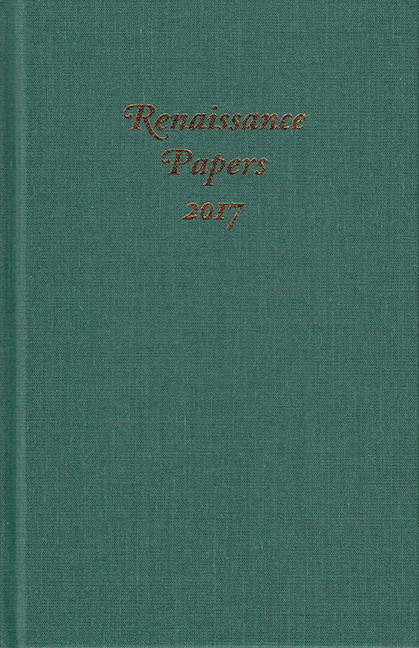Book contents
- Frontmatter
- Contents
- Dedication
- The Contested Pliability of Sacred Space in St. Paul's Cathedral and Paul's Churchyard in Early Modern London
- Classicism from Urbino: The Bichi Chapel Frescoes by Francesco di Giorgio Martini
- Visualizing the Paragone in Francisco de Zurbarán's Crucifixion with a Painter
- A Change in the Making: Shakespeare's Ovidian Sleep of Death and Display
- Old Black Rams and Mortal Engines: Transhumanist Discourse in Othello
- Dying with Speed and Felicity: Humor and Death in Book 3 of the Faerie Queene
- “If Devils Will Obey Thy Hest”: Devils in Dr. Faustus and The French Historie
- Rewriting Lucrece: Intertextuality and the Tale of Lucrece
- Economy and “Honesty” in Thomas Middleton's A Chaste Maid in Cheapside
- Glossing Authorship: Printed Marginalia in Aemilia Lanyer's Salve Deus Rex Judaeorum
- Botany and the Maternal Body in Titus Andronicus
- Unhorsing the Lustiest Challenger: Reflections on Chivalry in Richard II and Henry IV, Part 1
The Contested Pliability of Sacred Space in St. Paul's Cathedral and Paul's Churchyard in Early Modern London
Published online by Cambridge University Press: 04 April 2019
- Frontmatter
- Contents
- Dedication
- The Contested Pliability of Sacred Space in St. Paul's Cathedral and Paul's Churchyard in Early Modern London
- Classicism from Urbino: The Bichi Chapel Frescoes by Francesco di Giorgio Martini
- Visualizing the Paragone in Francisco de Zurbarán's Crucifixion with a Painter
- A Change in the Making: Shakespeare's Ovidian Sleep of Death and Display
- Old Black Rams and Mortal Engines: Transhumanist Discourse in Othello
- Dying with Speed and Felicity: Humor and Death in Book 3 of the Faerie Queene
- “If Devils Will Obey Thy Hest”: Devils in Dr. Faustus and The French Historie
- Rewriting Lucrece: Intertextuality and the Tale of Lucrece
- Economy and “Honesty” in Thomas Middleton's A Chaste Maid in Cheapside
- Glossing Authorship: Printed Marginalia in Aemilia Lanyer's Salve Deus Rex Judaeorum
- Botany and the Maternal Body in Titus Andronicus
- Unhorsing the Lustiest Challenger: Reflections on Chivalry in Richard II and Henry IV, Part 1
Summary
As Malcolm Gaskill has recently pointed out, “Teleological narratives suck drama from history, obscuring difficult choices behind final decisions and actions.” Nowhere is this truer than in the recent historiography of the English Reformation. Revisionist historians of the late twentieth century rightly criticized earlier historians for whom the English Reformation developed by design through an ordered process of reform along a “middle way” between Roman Catholicism and Protestantism. Yet revisionists have introduced their own teleological narrative, one in which the Church of England—after an early Lutheran phase—rapidly became Calvinist, for all intents and purposes, and would have shed the inconvenience of its Book of Common Prayer if the book's editor, Thomas Cranmer, had only lived to spearhead a third revision. In this narrative, only Elizabeth I's liturgical conservativism saved any sense of continuity with, or reverence for, England's religious past, or any distinctive features of the emerging religious tradition we now call Anglicanism.
One would think it inevitable that, given the situation of the post-Reformation English Church as a national church, regular attendance to whose services was required by law and baptism into which every child born in England was required by law, there would be a variety of beliefs and styles of practice within it, as well as a variety of interpretations of its beliefs and practices. Milton is surely right that the sixteenth century in English religious life was a period of “conflict and change … of multiple reformations, multiple settlements, and multiple trajectories of religious change.” As a result of this, any concept of a single orthodox identity or teleology of development in the early days of Anglicanism is surely an ex post facto construction by one church party or another seeking authentication for its status in our world as the truly orthodox embodiment of Anglican identity.
A better approach to the question of the origins of Anglican identity might well be to attend to conflict and change, to explore key developments and their interaction over time, rather than seeking a moment of stasis or clarity, and especially to explore the experiences of change in England's religious life, not just their specific textual formulations.
- Type
- Chapter
- Information
- Renaissance Papers 2017 , pp. 1 - 16Publisher: Boydell & BrewerPrint publication year: 2018

